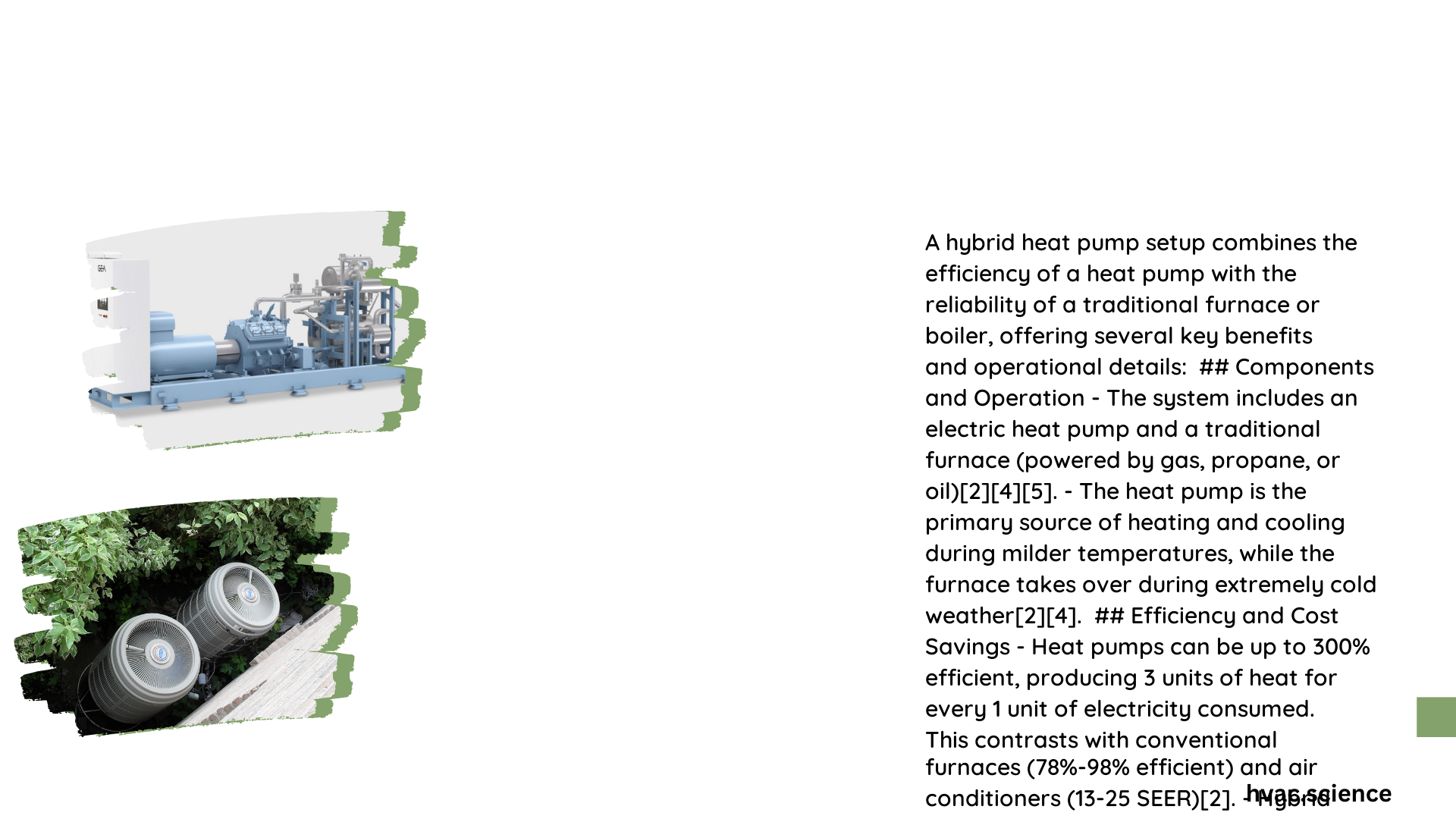A hybrid heat pump setup combines the efficiency of a heat pump with a traditional heating system, offering optimal performance and energy savings. This system automatically switches between the heat pump and conventional heating based on outdoor temperatures and energy costs. The installation process involves careful planning, proper equipment selection, and professional expertise to ensure maximum efficiency and comfort.
What is a Hybrid Heat Pump Setup?
A hybrid heat pump setup is an innovative heating and cooling solution that combines an electric heat pump with a conventional gas furnace. This system leverages the strengths of both technologies to provide efficient, cost-effective climate control throughout the year.
Key components of a hybrid heat pump setup include:
- Heat pump (outdoor unit)
- Gas furnace (indoor unit)
- Air handler
- Thermostat with dual fuel capabilities
The system operates by:
- Using the heat pump for heating and cooling when outdoor temperatures are moderate
- Switching to the gas furnace when temperatures drop below a certain threshold
- Automatically selecting the most efficient and cost-effective heating method based on current conditions
What are the Benefits of a Hybrid Heat Pump Setup?

Hybrid heat pump setups offer several advantages over traditional heating and cooling systems:
-
Energy Efficiency: By utilizing the most efficient heating method based on outdoor temperatures, hybrid systems can significantly reduce energy consumption.
-
Cost Savings: Lower energy usage translates to reduced utility bills, with potential savings of 30-50% compared to conventional systems.
-
Versatility: Hybrid setups provide both heating and cooling capabilities, eliminating the need for separate systems.
-
Environmental Impact: Increased efficiency means lower carbon emissions, making hybrid heat pumps a more eco-friendly option.
-
Comfort: The system maintains consistent indoor temperatures by seamlessly switching between heat sources as needed.
How to Install a Hybrid Heat Pump Setup?
Installing a hybrid heat pump setup involves several steps and requires professional expertise. Here’s an overview of the process:
-
Site Assessment: A qualified technician evaluates your home’s heating and cooling needs, existing ductwork, and potential installation locations.
-
Equipment Selection: Choose appropriately sized heat pump and furnace units based on your home’s requirements and local climate conditions.
-
Outdoor Unit Installation:
- Prepare a level surface (concrete pad or equipment stand)
- Place and secure the heat pump unit
-
Connect refrigerant lines and electrical wiring
-
Indoor Unit Installation:
- Remove existing furnace (if applicable)
- Install new gas furnace or air handler
-
Connect ductwork and gas lines (for furnace)
-
Thermostat Installation: Install a compatible dual fuel thermostat capable of controlling both the heat pump and furnace.
-
System Testing: Perform comprehensive tests to ensure proper operation, including:
- Refrigerant charge verification
- Airflow measurements
- Temperature differential checks
-
Thermostat programming
-
User Education: The installer should provide detailed instructions on system operation and maintenance.
What are the Maintenance Requirements for a Hybrid Heat Pump Setup?
Regular maintenance is crucial for optimal performance and longevity of your hybrid heat pump setup. Here’s a maintenance checklist:
Monthly Tasks:
- Clean or replace air filters
- Clear debris from around outdoor unit
Seasonal Tasks:
- Inspect and clean outdoor coils
- Check refrigerant levels
- Lubricate moving parts
- Test thermostat operation
Annual Professional Maintenance:
- Comprehensive system inspection
- Electrical component check
- Ductwork evaluation
- Safety controls testing
What are the Costs Associated with a Hybrid Heat Pump Setup?
The costs of a hybrid heat pump setup can vary based on several factors:
| Cost Component | Typical Range |
|---|---|
| Equipment | $4,000 – $10,000 |
| Installation | $2,000 – $6,000 |
| Ductwork Modifications (if needed) | $1,000 – $3,000 |
| Annual Maintenance | $150 – $300 |
Additional considerations:
- Energy Savings: While upfront costs may be higher, long-term energy savings can offset the initial investment.
- Rebates and Incentives: Many utility companies and government programs offer rebates or tax incentives for installing energy-efficient systems.
- Financing Options: Some HVAC companies offer financing plans to help spread out the cost of installation.
How to Choose the Right Hybrid Heat Pump Setup?
Selecting the appropriate hybrid heat pump setup for your home involves several considerations:
-
Home Size and Layout: Ensure the system is properly sized for your living space.
-
Climate: Consider your local weather patterns and temperature extremes.
-
Existing HVAC System: Evaluate compatibility with your current ductwork and heating system.
-
Energy Efficiency Ratings: Look for high SEER (Seasonal Energy Efficiency Ratio) and HSPF (Heating Seasonal Performance Factor) ratings.
-
Brand Reputation: Research manufacturers known for reliability and customer support.
-
Warranty Coverage: Compare warranty terms for both equipment and labor.
-
Professional Recommendations: Consult with qualified HVAC professionals for expert advice tailored to your specific needs.
By carefully considering these factors and working with experienced professionals, you can ensure that your hybrid heat pump setup provides efficient, comfortable, and cost-effective climate control for years to come.
